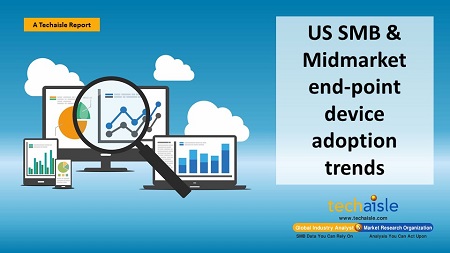IT markets tend to be complex and fast-moving – but even by IT industry standards, the endpoint device market in 2017 is extremely complex, and subject to significant and abrupt changes, as shown in Techaisle’s US SMB & Midmarket PC Purchase trends survey. The acceptance of multiple screens, coupled with the availability of new platform technologies, has created a market where “endpoint devices” span a wide range of device categories: desktop PCs, notebook PCs, tablets and smartphones, as well as thin clients, All-in-Ones, and other device types. Consider the following trends – some of which have played out over several years, and some of which are scant months old – and how they might affect buyers and suppliers of client technology this year:
1. PC at the center of business productivity: The definition of “personal productivity” technology may have changed but PCs are still at the center of business productivity. The business workplace is defined by where the user and his device is and PCs follow where the user is and becomes the device of productivity. 55% of SMBs say that newer PCs give them the ability to work from anywhere, any time. More than half of midmarket firms report improved experiences with mobility (66%), collaboration (59%) and the ability to use cloud solutions (52%) with newer PCs.
2. High demand but subject to business pressures: 40% of SMBs are planning to purchase at least one PC in 2017. If all keep to their PC purchase plan, then US SMBs businesses will likely purchase 11.7 million PCs in 2017. The most likely US SMB PC purchase scenario for 2017 is 8.4 million units.
3. Newer PCs empowering mobile workforce: Survey data also shows that by the end of 2017, 55% of US SMBs’ business workforce will be mobile, equating to 36 million employees. (63% of small business’ workforce at 27 million). Increased mobility within small businesses requires PC devices that provide a better experience, improved productivity, enhanced security & easy manageability and today’s PCs based on Windows 10 provides the necessary impetus for a digital and mobile SMB, thus empowering the workforce.
4. Year of the notebook: 2017 may very well be the year of the notebook. All SMBs planning to purchase a PC will at least acquire a notebook in a complete departure from previous years’ trend. It has become common to ‘blame’ declines in the PC market on growth in tablets. Tablets were never notebook replacements when they were first introduced and they are still not replacement devices. In 2014 65% of SMBs purchased Tablets as additions to PCs, in 2017 they will still be additions at 71%.
5. Disappearing PC refresh cycle concept: 55% of small businesses do not have any PC refresh policies and 42% are actually keeping their PCs in use longer than in previous years. 33% of midmarket businesses are also keeping their PCs in use longer. Another 34% of midmarket firms mention that they refresh their PCs as per their replacement cycle policy but then they have also extended the refresh cycle to 61 months. When comparing the 2016 and 2017 PC replacement time periods, data shows that small businesses are opening up to lowering the timeframe but midmarket businesses are increasing the timeframes quite drastically.
6. Small & midmarket firms shopping in different aisles: Small businesses and midmarket firms have completely different preferred channels for PC purchases. The data also points to the fact that PC purchases within midmarket businesses is deliberate and planned as opposed to ad hoc and need-driven within small businesses. US small business buyers, who are often looking for a straightforward approach to these products, tend to rely on technology/electronic retailers, small local dealers/resellers/retailers as well as PC manufacturers. Midmarket businesses, which tend to have more complex integration requirements than small businesses, have a different supply mix. Many of these firms look to manufacturers first as a PC source and use higher-skilled channel partners, such as VARs, as a source of PC products.
7. Meaningful information sources front-and-center: The information sources and the channels of information have changed. Small businesses are using more practical and actionable information sources which guide them to make informed and actionable decisions. They want to spend as little time as possible on the mental process of identifying a brand, selecting a configuration, price-comparisons, migrating applications & data. Midmarket businesses are using information sources that outline case studies and white papers that explain several different aspects of security, manageability and fit with business issues as well as IT challenges.
8. Chromebooks demand wishy-washy: SMBs are having a love-hate relationship with Chromebooks. The penetration fell in 2016 as compared to 2015. The initial euphoria gave way to disappointment. Data suggests that small businesses use Chromebooks as a shared resource. Interestingly, price is not ‘the’ reason for purchasing and using Chromebooks.
9. iOS Tablets dominating SMBs, Windows Surface showing up in VSBs: Within the last one year Tablet penetration increased by 18% within small businesses and 11% in midmarket firms. Within the SMBs, Tablet penetration has still not reached 100%. It took PCs more than three decades to reach full penetration but it has already reached 69% penetration for Tablets in just 5 years. There is an increase in intent-to-purchase Windows-based Tablets in the very small businesses. This is also because of the growing popularity of Windows Surface PCs. Midmarket businesses are finally getting to incorporating iOS tablets in their IT and corporate plans.
10. On-premise severs not dying, except in VSBs: The most important server trend evident from the data is a drop in on-premise server usage within the very small businesses as they are preferring to use cloud-based servers whether as a private cloud instance or public cloud.
